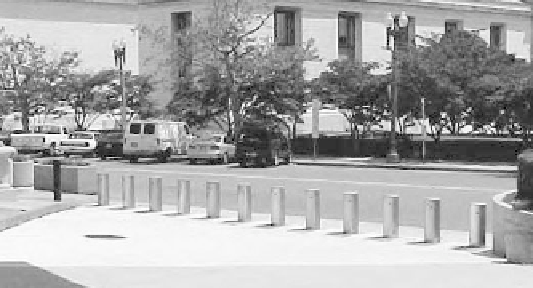Travel Reference
In-Depth Information
mechanically operated systems is generally between 5 and 7 seconds. One
very useful option Delta offers is a circuit that will allow the barricade to
be deployed in six-tenths of a second in emergencies. The system can even
be tied into sensors that will cause the system to be automatically deployed
upon detection of a vehicle approaching at high speed. The system offered
by Delta uses sensors embedded in the roadway remote from the guard
booth. It can be set to trigger an alarm or deploy the barricades auto-
matically without the need for human intervention. Exhibits 12.4, 12.5,
and 12.6 are examples of several of Delta's excellent designs as well as tests
of their effectiveness.
Exhibit 12.4
Delta Scientific's Bollards Providing
Protection at the U.S. State Department
Photo courtesy of Delta Scientific.
Exhibits 12.5 and 12.6 show the DSC 720 bollard system, manufactured
by Delta Scientific, during a crash test. Two of the three hydraulically oper-
ated bollards remained fully functional after this test despite the 1.2 mil-
lion foot-pound impact. This is Delta's highest-rated system and is actually
rated to stop even larger, heavier vehicles striking at high speed. It will stop
a 15,000-pound truck even if it strikes the bollards at a speed of 50 mph.
Enhancement of physical security through the installation of such a
system also has a deterrent value that should not be underestimated. The
use of sturdy and effective barricades will likely encourage a potential
attacker to find a “softer” and less well-protected target. However, there
are always those not in favor of installing such systems. A common criti-
cism while discussing the placement of bollards and barricades is the fact
that no one wants to feel as though their place of employment is an armed




